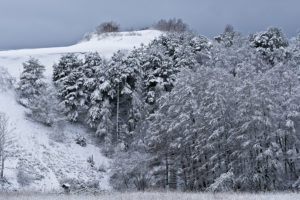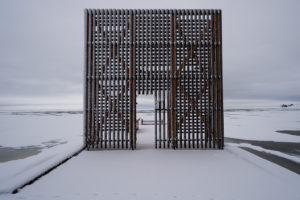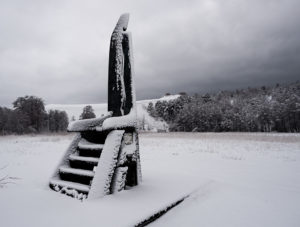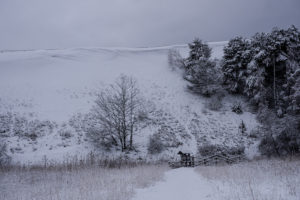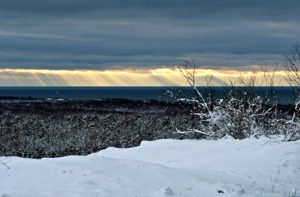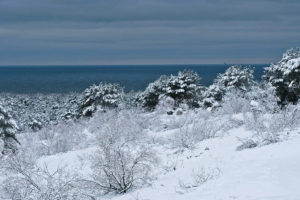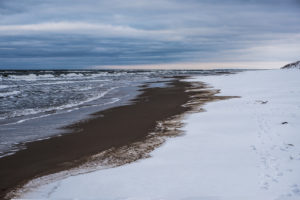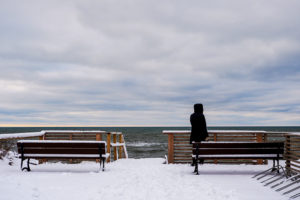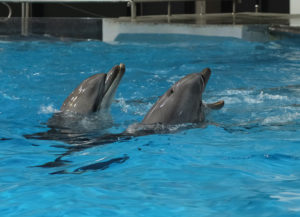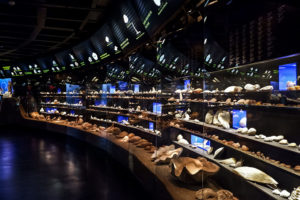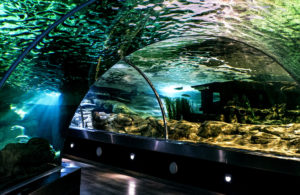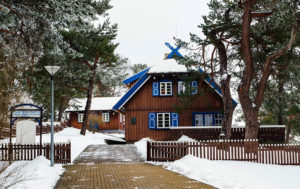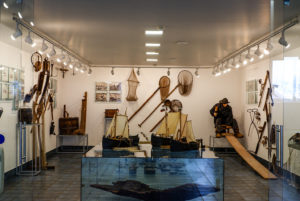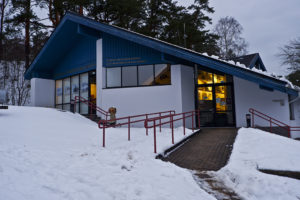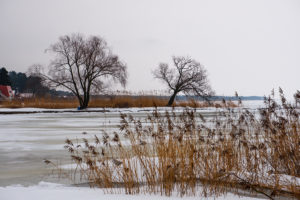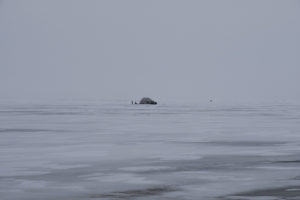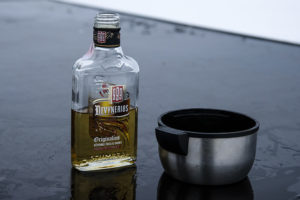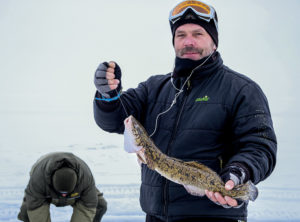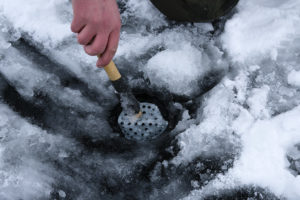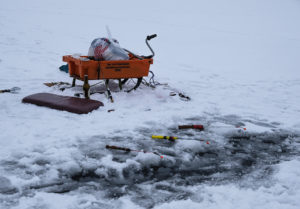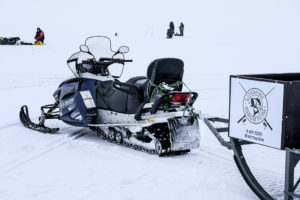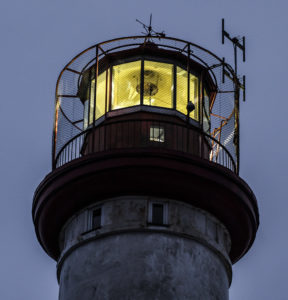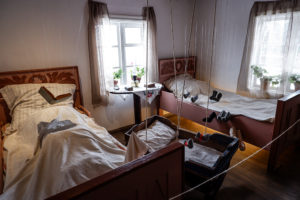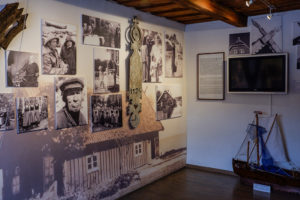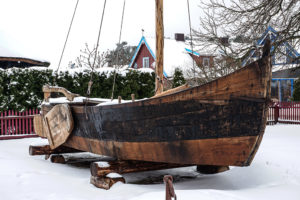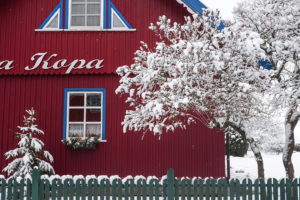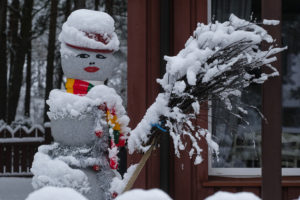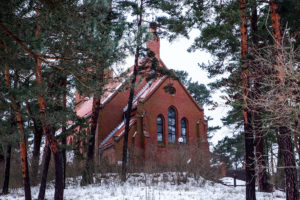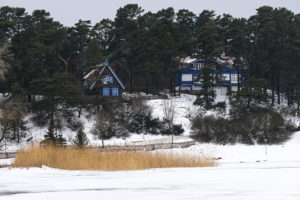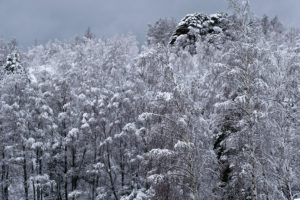The Curonian Spit, Neringa in Lithuanian, is a 98 km long and thin stretch of land. It separates the lagoon from the Baltic Sea. Lithuania owns 53 of those kilometers, while the rest belongs to the Russian enclave of the Kaliningrad oblast. It is a truly unique place, with its majestic dunes reaching incredible heights. The widest section of the peninsula measures 4 km in width, the narrowest only 380 meters. In 2000, the peninsula became a UNESCO World Heritage Site. Most of its surface is covered in woods, an ideal environment for foxes, elks, roedeer and many species of birds: herons, sea eagles and big cormorants.
People love to come here in the spring and summer, but I decided to come here at the end of January, because the Curonian Spit can be quite enchanting in the winter too.
Travel Journal
The sunset just a memory, it is dark outside now. I am staying in an apartment close to the catholic church in Nida. It is quite cold outside and I am grateful for the heat that I find indoors. My thoughts are to the day that awaits me tomorrow. I watch the weather reports, they say it will snow tonight. I have been on the Curonian Spit for two days now. There isn’t much snow and the lagoon has frozen over. Not like the first time I was here, when the layer of ice was more than 40 centimeters thick. Now it is around 15 centimeters thick, but the beauty of the lagoon is still impressive.
I wait anxiously for the snow that’s coming. I make sure my camera is ready, I take a look at the pictures I’ve taken so far, I go over the maps of the park one more time. Before going to bed, I take a short walk around the neighborhood. I meet a couple of guys, they are guests of the Nida Art Colony, a sort of art incubator that hosts young artists from all over the world and they come here to work on their projects. We exchange a smile, they are putting up some strange installation.
During the night, I wake up a few times. When it is dead silent like this, a strange feeling washes over me. Something is happening. Maybe it’s the muffled noises, maybe it’s the cold light filtering through the windows but… I don’t want to see it. I want to be surprised tomorrow. I can feel it: it is snowing.
Untouched nature
I wake up early. Outside, a magnificent view awaits me. A lot of snow came down last night, and a thick white blanket covers all things. I start walking towards the lagoon. I cross the Valley of Silence. Nobody walked here before me. The footprints belong only to animals: deer, elks and foxes. And birds. It is truly magical. It moves to tears. I climb the white Parnidis Dunes, the highest in the peninsula, about 53 meters. From up there one can enjoy a breathtaking view: on the Eastern side, the lagoon; on the Western side, the Baltic Sea. You can see both sunrise and sunset. I am just a few kilometers from the Russian border at Kaliningrad.
On the summit, there is a sundial with a giant stone pillar about ten meters high. Its shadow indicates the time, while at the base, a few sculptures indicate solstices and equinoxes.
Only in winter, and only when the dunes are covered in a thick layer of snow, it is possible to walk anywhere without having to follow the established wooden paths. Only some areas are forbidden during winter too. And rightfully so: the dunes represent a fragile ecosystem that needs to be protected. They are made of thin, white sand that is rich in grains of quartz. Scientists estimate that the dunes move from 0.5 to 10 meters every year, depending on the wind force.
I go down the other side along magical white paths. My footsteps are the only sound. I am alone. Back in the valley, I walk towards the sea. A woman comes out of her house and walks in the same direction. We look at each other. We smile. She asks whether I am a guest of the art colony. There aren’t so many tourists in the winter, so the only foreigners are almost all students and young artists. She doesn’t speak English. We speak in the universal language of hand movements and facial expressions, sprinkled with some English and Lithuanian words. I speak very little Lithuanian, but we still manage to communicate and so we walk together.
After a while, the crashing of the waves becomes too loud, it is almost deafening. And here it is, the Baltic sea. Below us, the white beach: on the water’s edge the snow has melted, leaving the sand exposed. On the horizon, dark blue clouds and a few shy sunrays. We are left speechless, so we just stare at the view. We go down. She waves at me and goes off by herself. I stop to take a few pictures and listen to the sea. After a while, she becomes a tiny dot, dark against the bright light of the snow. I walk back towards Nida, taking only secondary paths that lead me to enchanted areas. The more space I put between myself and the sea, the more silent it gets.
LOOK AT PHOTO GALLERY
Nature and culture, museums
The Curionian Spit is not just nature. The museums, albeit small, tell the stories of these places: its traditions, culture, history, the difficult lives led by the fishermen. Museums detailing the life of the famous people who came here during the summer. They worked and shared their ideas and their experiences with the local community.
Nida, the major city in the peninsula, is right by the Russian border. It is a small town with typical, colorful wooden houses. One of these buildings houses the Fishermen Ethnographic Museum. It was built at the beginning of the 20th century and it was restored after it was destroyed in a storm. In the yard there is an old well and some old fishing boats, among these the typical boat from Neringa, the “Kurėnas”. Inside, the museum illustrates the life of the fishermen through some furniture and original artifacts. The kitchen has a majolica stove, dishes and an over to bake bread; there‘s the bedroom with the children‘s crib, the living room, fishing nets and everyday objects. Many pictures from the past century are on display, while others scroll on a screen. A modern building hosts the History Museum. Visiting it means taking a dive into the lives of the people who inhabit the peninsula. From local artifacts to fishing equipment, from old fishing boat replicas to documents and photographs, everything is there to tell the stories of these people.
Not far from that, there‘s the Thomas Mann House Museum: the German writer stayed in Nida for three summers between 1930 and 1932. I remembered visiting it in the warm seasons and it found a place in my heart. Mann had it built after a first visit here in 1929. The architect, Herbert Reismann, took inspiration from the old fishermen’s houses. A big terrace offers wonderful views of the lagoon. In the Memorial Museum one can find books, articles, essays and letters by Thomas Mann. It isn’t hard to imagine him sitting at his desk, writing. Imagining him spending his days here together with his family, before the turn of events forced him to emigrate to the USA. His wife was Jewish.
Thomas Mann wasn’t the only one keeping alive the cultural life of Nida in the 20th century. Not far from his house is the Museum of the hotel Hermann Blode, also called “Artist House”. Starting from the end of the 19th century, painters, writers and musicians stayed here. The original building was all but destroyed during the Soviet times, but some parts are still visible from the original structure. Today, the building houses the Nidos Banga hotel.
At the beginning of the peninsula in Smiltynė, where the ferry from Klaipėda docks, there are the Sea Museum and the Dolphinarium. Once, there was the Neringa fort there. A visit here could be interesting to explore the flora and fauna of the Baltic Sea and the lagoon, but also to discover species from the tropical seas. There is also a rich shell collection. Almost any species of fish can be found in the huge tanks, while penguins, seals and sea lions live in the pools. Where the fort and the pillboxes once were, now there is a very insightful exposition dedicated to the Lithuanian sailing history. The Delphinarium was opened in 1994 with a clear educational purpose: in fact, many initiatives are geared towards teenagers and children so that they come into contact with marine mammals and learn how to respect this very fragile ecosystem. The dolphins in particular are also part of a project that helps mostly disabled and autistic children through “dolphin therapy”.
Ice fishing
The lagoon has frozen over. The sun is coming up. It’s a chilly morning, but I am wearing warm clothes. There is no wind. I am walking on ice. There is nobody around me. It’s still early and I am the only one enjoying this view. And the silence.
I am meeting with Kristina and Saulius to go to the lagoon where the fishermen are ice fishing. Southern Europeans like myself are used to seeing this only in the movies. They drill a hole in the ice, then they just sit and wait. Every fisherman has their secret recipe for a good bait and a good spot for finding lots of fish.
Saulius has a snowmobile with which he takes people and fishing gear on the lagoon. I climb on behind him and we leave. The wind feels so harsh on my skin, I try to keep my eyes open and watch… the nothingness before me. The whiteness of ice, snow and sky make me doubt my sense of direction. Only by turning my head towards the coast and the colorful wooden houses can I finally get my bearings. It feels nice. We stop more or less three kilometers from the shore. We have about ten fishermen focused on the job at hand. In the far distance, I can make out a few tents. The fishermen will spend the night on the lagoon.
When the wind blows, the cold can be quite intense even during the day. The fishermen use small tents for shelter.
Saulius offers me some hot tea mixed in with a little alcohol. A very strong, local herb liquor. It’s a fine drink, and it certainly warms you up. While we sip our tea, he explains to me one of the techniques that they use to ice fish: the trick is to rhythmically sway the fishing pole as to attract the fish. I try to do it myself, replicating the same regular, slow movements, but I am not so good at it. We laugh at my inexperience. A fisherman a few steps from us looks at me smiling and, lifting his rod, shows us his catch: a great fat fish!
It is now time to go back to the shore. The snowmobile comes up to us slowly. The air is now colder that when we came, but my happiness is much stronger too (translated by Inglese Americano)


